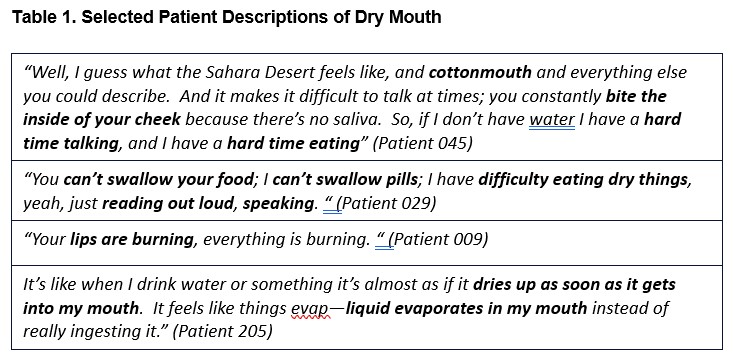Session Information
Date: Sunday, November 12, 2023
Title: (0325–0344) Patient Outcomes, Preferences, & Attitudes Poster I
Session Type: Poster Session A
Session Time: 9:00AM-11:00AM
Background/Purpose: Xerostomia (dry mouth) is one of the most prevalent symptoms experienced by patients with Sjögren’s Disease (SJD). The Xerostomia Inventory (XI) is a 11-item PRO that has been used primarily to assess the impact of xerostomia on oral health in older populations. The purpose of this study was to identify important symptoms and impacts of dry mouth described by SJD patients and explore the content validity of the XI for use in SJD clinical trials.
Methods: US participants with physician-confirmed diagnosis of SJD were recruited in partnership with the Sjögren’s Foundation. Combined concept elicitation (CE) and cognitive interviews (CI) were conducted by telephone or online platform with 29 adult patients experiencing dry mouth due to SJD. CE identified dry mouth symptoms and impacts on activities of daily living. During CI, patients completed the XI and discussed the relevance of each item, clarity of wording, ease of completion, response options, comprehensiveness, and relevancy of the recall period. Interviews were audio-recorded, transcribed, and anonymized. A thematic analysis of the CE data was facilitated by MAXQDA software and a codebook developed from patient interviews. An item-matrix tracker was adopted to capture patient comments on the items and other elements of the XI and to record indicated revisions, additions, or deletions based on patient feedback.
Results: The study participants were primarily female (96%), White (79%), had a bachelor’s degree or higher (90%), with mean age 62.8 years (range 33-74). Over 70% of patients reported experiencing dry mouth daily or all of the time; symptoms included difficulty swallowing (59%), eating (52%), speaking (62%), having an unquenchable thirst (10%), burning (10%), dry mouth (100%) and dry lips (14%) (Table 1). Patients described coping strategies including use of products like mouthwash, gum, or oral melts (76%), and carrying water with them (35%). Patients found XI instructions easy to understand (95%), easy to respond to (79%), the items relevant to their experiences (68-100%), and response options appropriate (85%). XI concepts mapped moderately well to patient-reported symptoms. Items concerning difficulty eating (96%) and swallowing (91%) were highly endorsed by patients. Concepts reported by patients but not included in the XI were dental issues (62%) and speaking difficulties (62%). 50% of patients reported that items about dryness in other anatomical areas in the XI did not fit with a PRO to assess dry mouth. Patients identified regional colloquialisms that should be modified to more general terms. Patient input provided clear directions for item eliminations, additions, and rewording needed to develop a revised XI that is relevant and measures concepts important to SJD patients.
Conclusion: These findings reveal the array of dry mouth symptoms SJD experience and support the need for a PRO that comprehensively assesses patients’ experiences. This study demonstrates the utility of a modified XI for assessing dry mouth experienced by SJD patients. Further research can help assess the content validity of a revised XI for use in SJD.
To cite this abstract in AMA style:
Kruzikas D, Eldred A, Kafka S, Church J, Hammitt K, Koochaki P, O'Donnell C, Thomson W. Sjögren’s Disease Patient Experiences with Dry Mouth and Content Validity of the Xerostomia Inventory [abstract]. Arthritis Rheumatol. 2023; 75 (suppl 9). https://acrabstracts.org/abstract/sjogrens-disease-patient-experiences-with-dry-mouth-and-content-validity-of-the-xerostomia-inventory/. Accessed .« Back to ACR Convergence 2023
ACR Meeting Abstracts - https://acrabstracts.org/abstract/sjogrens-disease-patient-experiences-with-dry-mouth-and-content-validity-of-the-xerostomia-inventory/

